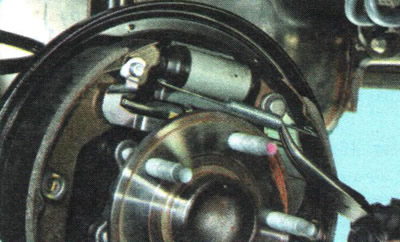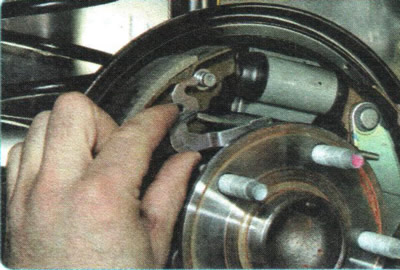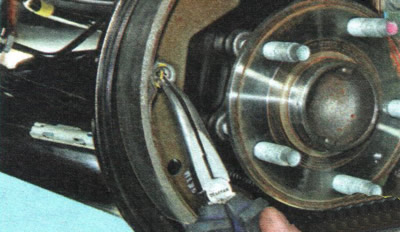The minimum allowable thickness of the friction linings of the brake pads is 1.4 mm.
Replace pads in the following cases:
- the thickness of the friction linings is less than the permissible one;
- the surface of the pads is oiled;
- the friction lining is loosely connected to the base;
- linings have deep grooves and chips.
WARNINGS: Do not use gasoline, diesel fuel or any other mineral solvents to clean brakes.
Replace pads simultaneously in the brake mechanisms of both rear wheels. It is unacceptable to replace the front and rear pads with each other, as well as between the left and right wheels. This can lead to uneven braking.
1. Engage 1st gear in a manual transmission or set the automatic transmission control selector lever to position «R» (parking) and place chocks under the front wheels.
2. Check that the parking brake lever is pushed all the way down (the car is disinhibited).
3. Hang out a back wheel and establish a back part of the car from replaced brake pads on a support. Remove the rear wheel.
4. If the brake fluid level in the master cylinder reservoir is at «MAX» or approaches it, pump some of the fluid out of the tank. Otherwise, when replacing the pads, it may splash out.

5. Remove the brake drum (see «Removal and installation of a brake drum»).

6. Screw the gap adjuster nut all the way onto the threaded shank of the spacer bar with a screwdriver, resting it on the edge of the hub, as shown in the photo.

7. Grab the bent end of the upper coupling spring with pliers...

8.... remove it from the groove of the earring of the clearance adjustment mechanism...

9.... and remove the upper return spring.
WARNING: Be careful when working with pliers. We recommend using special pliers to remove the coupling springs.

10. Remove the gap adjuster shackle...

11.... and spacer bar.

12. Holding the shank of the support post with pliers, press the washer, turn it 90°...

13....and remove the washer...

14....spring...

15.... and a support rack of the front shoe.
16. Similarly remove a washer, a spring and a basic rack of a back block.

17. Overcoming the resistance of the lower return spring, remove the toes of the brake shoes from the bottom stop stop to loosen the spring tension.
WARNING: Immediately after removing the pads from the brake shield, secure the pistons of the working cylinder in any way possible (for example, tie with a rubber band or tie with wire), Otherwise, the pistons may be pushed out of the cylinder by the spacer spring and brake fluid will leak out of the hydraulic system.

18. Having disconnected the bent end of the lower coupling spring from the front shoe, remove the shoe...

19.... and a spring.

20. Remove the tip of the parking brake cable from the slot of the expanding lever and remove the rear brake shoe.
21. Clean and inspect brake parts (pic. 9.5). Replace deformed or heavily corroded parts. Strongly stretched, lost elasticity and bent springs replace.

GOOD ADVICE: Whenever dismantling the brake mechanism, replace the pressure springs, washers and support legs with new ones.

NOTES: The left brake lash adjuster parts are not interchangeable with the corresponding right brake parts. The left adjuster has a left hand thread, the right has a right hand thread.

Front A and rear B rear brake pads are different in design (at the front block, instead of a finger for attaching the expanding lever, the axis of the earring of the gap adjustment mechanism is installed). In addition, the rear brake pad assembly with expanding levers is different as left and right.

22. Apply refractory brake grease to the friction points of the front and rear brake pads on the brake shield.
USEFUL ADVICE: When replacing brake pads, we recommend replacing the spacer bars assembled with clearance adjusters if they have begun to corrode, since during further operation corrosion can cause clearance adjuster failure.
23. Release the pistons of the working cylinder from the fixing device, squeeze the pistons of the working cylinder with sliding pliers and install the brake shoes in the reverse order of removal.
WARNING: Keep in mind that when the pistons are sunk into the cylinder, the level of brake fluid in the reservoir of the master brake cylinder rises. Pump out the fluid if necessary.
24. Install the brake drum (see «Removal and installation of a brake drum»).
25. Adjust the gap between the brake shoes and the drum by pressing the brake pedal 10-15 times. Each time you press it, you should hear the knob click. If the clicks stop, the clearance is set.
26. Reinstall the wheel. Check for ease of rotation.
27. Similarly, replace the brake pads of the brake mechanism of the other wheel.
28. After installing the brake pads, adjust the parking brake system (see «Parking brake actuator adjustment»).
